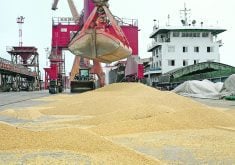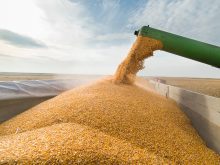They’ve parked the combines and most prairie farmers are now working hard with another critical farm tool: the pencil.
It’s time to figure out how much is in the bins and what the world is willing to pay for it.
This year farmers are coming to depressing conclusions on both production and marketing, but advisers say this is a crucial period for establishing a marketing plan that will make the most of the 2004 crop.
“You had expectations when you seeded the crop but those have probably changed, especially this year,” said Scott Stothers, manager of farm management advice for Manitoba Agriculture.
Read Also

Defence investments could benefit agriculture
A bump in Canada’s NATO spending commitments could lead to infrastructure investments that would benefit rural areas
“People need to be looking at what they harvested, today’s prices versus their expectations, and start planning from there.”
Ken Ball, a broker with Benson Quinn-GMS, recommends farmers start calculating the value of their binned crops on a regular basis.
“At least once a week, maybe even once a day, I think you should be plugging in an estimated price times an estimated yield,” said Ball.
Many farmers are unaware of how and why prices vary during the main marketing months after harvest, but by charting market prices and what drives them, they can identify various types of financial exposure.
“You should know exactly why the value of these crops fluctuates every day or every week,” said Ball.
For instance, farmers can follow the recently lower value of canola and connect that to the decline of soybean prices and the increasing value of the Canadian dollar. While the connection between canola prices and the value of the Canadian dollar is not dollar-for-dollar, it tends to be close.
By regularly analyzing the value of a crop and separating out the dynamics in the price, farmers can work out their risk factors.
“If the value is fluctuating because of variation in the Canadian dollar, then you’ll become very conscious of it on your farm,” said Ball.
This concept is akin to marking-to-market, a practice used by investors such as mutual fund managers. For many funds, the value of the portfolio is adjusted daily so that shareholders and potential investors can accurately gauge its worth. This practice is required by law, but most financial managers would do it anyway because it records changes in value quickly.
Marking-to-market helps eliminate unpleasant surprises.
Farmers don’t have a legal requirement to regularly assess their crop’s worth, but they should do it, Ball said.
“Once a week is probably enough if you do it diligently,” said Ball.
Stothers said farmers need to develop a rational post-harvest marketing plan that is disciplined and based on earning a profitable return, not attempting to guess the top of the market.
“Once you know (your cost of production), you can lock in a profit level and set some marketing targets,” said Stothers.
“At least sell a portion (when prices become profitable.) Don’t get into hold-off marketing, where when the price gets to your $8 target, you hold off for $8.50.”
Stothers said farmers should do a post-harvest inventory of their crop, then calculate the crop’s value by current prices. By using accrual accounting, a farmer will get a good sense of his asset values.
He can compare that with his costs and see what he needs to earn to make a profit.
“You can determine where you need to go from there,” said Stothers.















